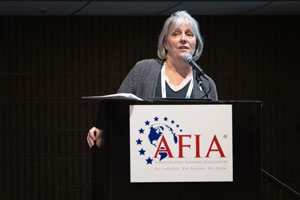
From the Editor: Movement to vaccinate gains momentum
Brett Ruffell
Features Disease watchVaccination could be key part of multilayered approach to reining in devastating virus.
 Dr. Louise Dufour-Zavala, executive director of the Georgia Poultry Laboratory Network.
Dr. Louise Dufour-Zavala, executive director of the Georgia Poultry Laboratory Network. Well, that didn’t take look. Just one week into 2023, Canada recorded its initial cases of highly pathogenic avian influenza (HPAI) in commercial flocks. A cluster of farms in B.C. were the first to report infections in the new year. Since then, a handful of barns in Quebec have reported outbreaks as well.
But just as experts long anticipated the arrival of the H5N1 strain in North America after watching it plague Asia and Europe for a few years, they also aren’t surprised that it’s still lingering here based on what’s transpired on other continents.
“I think we have to prepare that this virus is going to be around a long period of time through the spring,” says David Swayne, a poultry scientist with the U.S. Department of Agriculture and a respected expert in avian influenza. “And we don’t know, is this virus ever going to disappear or is it something we’ll be living with for the foreseeable future?”
While he stresses there’s no magic bullet to rein in the virus, he says the industry’s best line of defence is good biosecurity along with reporting, resting and eliminating infected flocks.
“Right now is the time for everybody to review their biosecurity plan,” Swayne stresses. He says every such blueprint should outline how birds are handled, how people and equipment are moved in and out of the barn and a no visitor policy. He also recommends producers scan their facilities for any weak points where the virus could enter and then take steps to address those gaps.
Longer term, experts around the world are increasingly contemplating vaccinating poultry against the virus. In fact, Mexico started vaccinating flocks late last year. “It’s always been a controversial thing,” says Tim Lambert, CEO of Egg Farmers of Canada. “But I think, logically, that’s where this needs to head.”
At the International Production & Processing Expo in Atlanta, Ga., this past January, Dr. Louise Dufour-Zavala, a Canadian who’s now executive director of the Georgia Poultry Laboratory Network, outlined the pros and cons of vaccinating flocks again avian influenza.
The main advantage is that it would make it more difficult for a flock to get infected. “It would take a lot more virus for a vaccinated flock to be infected,” she said. “So, we’d have fewer cases, less shedding, less spread and it would help eradicate the virus.”
The main disadvantage is vaccination is incompatible with trade, the rules around which are governed through the World Animal Health Organization (Canada is a member). But there are experts working on addressing some of the concerns member countries have. For example, Swayne says groups are looking to establish a surveillance program so that trading partners can be confident there is no virus in either the poultry meat, eggs or by-products they import.
Vaccinating against avian influenza would also be labour-intensive. That’s because there’s no mass vaccination available. Thus, it would have to be administered one bird at a time at either the hatchery or pullet farm. The vaccine would also have to be updated each year to match what’s circulating, the same as we do with flu shots for humans.
Despite these obstacles, with so many countries experiencing outbreaks, with the persistence of the H5N1 strain, and with an increasing number of cases of it spreading to mammals, the tide is turning in favour of vaccinating.
Dufour-Zavala advocates for a middle ground where we vaccinate to reduce spread, maintain good biosecurity and continue to stamp out all infected birds, even in vaccinated flocks. “It’s a very complicated issue. We don’t have an answer for this yet. But a lot of people are working on this.”
Print this page